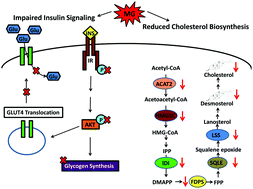Methylglyoxal attenuates insulin signaling and downregulates the enzymes involved in cholesterol biosynthesis†
Abstract
Methylglyoxal (MG) is a highly reactive dicarbonyl known to be elevated under the hyperglycemic conditions of diabetes and is implicated in the development of diabetic complications. Therefore, the current study investigates the role of MG in exacerbating insulin resistance at the insulin signaling level, as well as its effect on the global proteomic level. By using insulin sensitive rat muscle cells (L6) and Chinese hamster ovary (CHO) cells stably expressing the insulin receptor (IR) and a glucose transporter fused with green fluorescent protein (GLUT4-GFP), we have observed that MG impairs insulin signaling, inhibits GLUT4 translocation and reduces glucose uptake. SWATH MS analysis, a label-free quantitative mass spectrometric approach, showed altered expression of 99 proteins out of 2404 identified in response to MG treatment. These proteins are mainly involved in stress response, protein folding and proteolysis. Some of the deregulated proteins such as thioredoxin 2, glutathione S transferase, T complex protein 1 subunit β (tcbp1), heat shock protein 90 and E3 ubiquitin ligase were previously reported to be associated with either diabetes or insulin resistance. Interestingly, aminoguanidine (AMG), a potent dicarbonyl scavenger, restored the deleterious effects of MG. For the first time, we report that MG induces downregulation of enzymes involved in cholesterol biosynthesis such as acetyl-CoA acetyltransferase, hydroxymethylglutaryl-CoA synthase, farnesyl pyrophosphate synthetase, squalene monooxygenase, and lanosterol synthase. GC MS analysis for sterol metabolites corroborated the proteomic results; MG significantly reduced cholesterol production whereas AMG treatment restored cholesterol production to levels similar to the control. Thus, MG leads to primary defects in insulin signaling and cellular abnormalities at the proteomic and metabolic levels, both of which may contribute to the development of insulin resistance.



 Please wait while we load your content...
Please wait while we load your content...